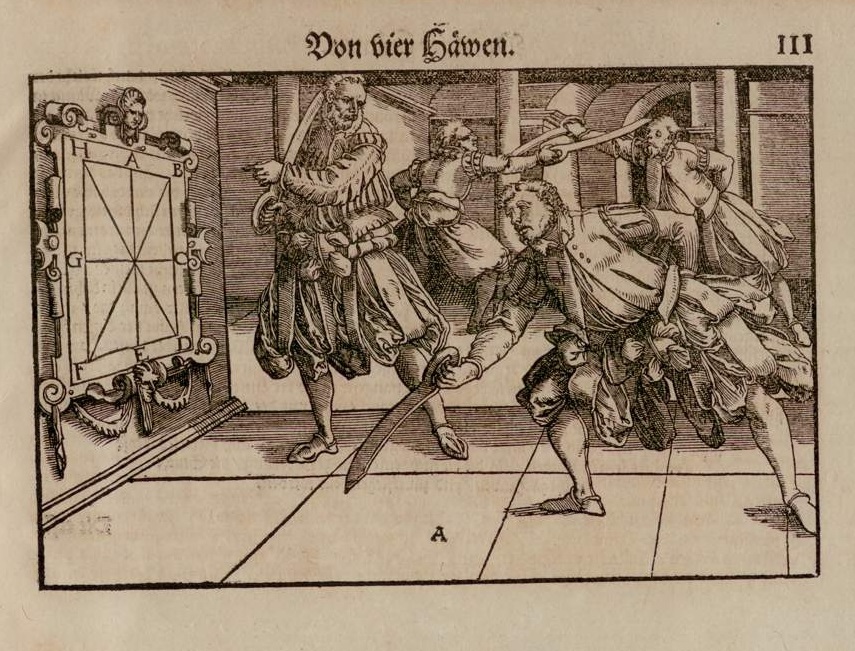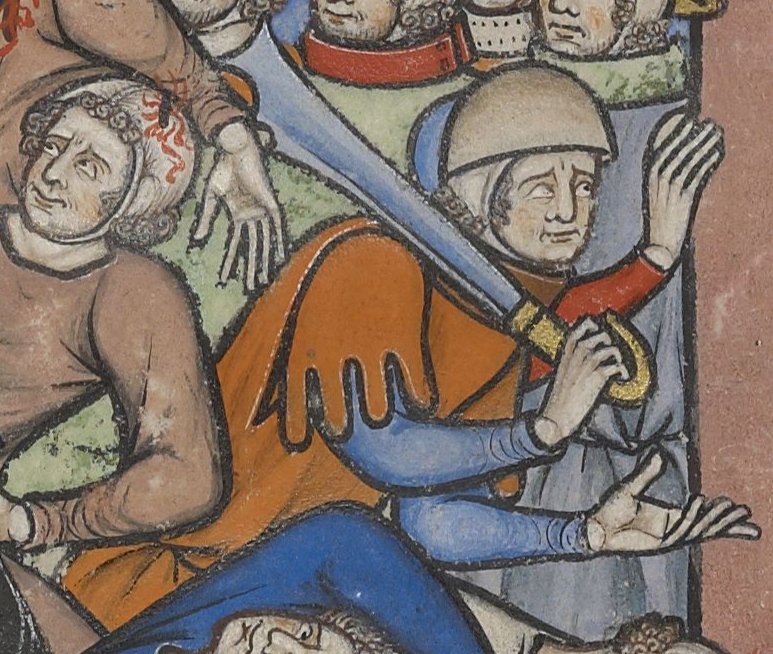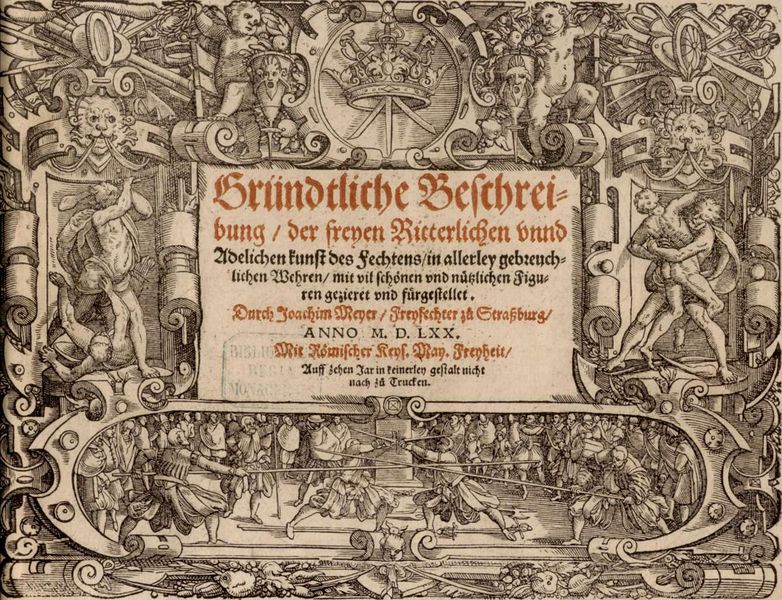|
Dussack
A dusack (also ''dusägge'' and variants, from Czech ''tesák'' "cleaver; hunting sword", lit. "fang") is a single-edged sword of the cutlass or sabre type, in use as a side arm in Germany and the Habsburg monarchy during the 16th to 17th centuries, as well as a practice weapon based on this weapon used in early modern German fencing. Military sidearm The Czech term entered German usage in the Hussite Wars, after the sidearm used by the Hussites. In the late 16th century, ''Dusägge'' could refer to a type of weapon combining a sabre blade with the hilt of a sidesword (the German ''Degen''), also known as ''Säbel auf Teutsch gefasst'' ("sabre fitted in the German manner"). The ''Dusägge'' in this sense was used as a military sidearm; e.g. in 1579, Styria records delivery of some 700 ''Dusäggen'' by local bladesmiths, besides payment of 40 ''Dusäggen'' delivered from Passau, as part of the preparation for the war against the Turks under Archduke Charles II. The Ger ... [...More Info...] [...Related Items...] OR: [Wikipedia] [Google] [Baidu] |
Waster
In martial arts, a waster is a practice weapon, usually a sword, and usually made out of wood, though nylon (plastic) wasters are also available. Nylon being much safer than wood, due to it having an adequate amount of flex for thrusts to be generally safe, unlike wooden wasters. Even a steel feder has more flex than most wooden wasters. The use of wood or nylon instead of metal provides an economic option for initial weapons training and sparring, at some loss of genuine experience. A weighted waster may be used for a sort of strength training, theoretically making the movements of using an actual sword comparatively easier and quicker, though modern sports science shows that an athlete would most optimally train with an implement which is closest to the same weight, balance, and shape of the tool they will be using . Wasters as wooden practice weapons have been found in a variety of cultures over a number of centuries, including ancient China, Ireland, Iran, Scotland, Rome, Eg ... [...More Info...] [...Related Items...] OR: [Wikipedia] [Google] [Baidu] |
Dussack 01
A dusack (also ''dusägge'' and variants, from Czech ''tesák'' "cleaver; hunting sword", lit. "fang") is a single-edged sword of the cutlass or sabre type, in use as a Sidearm (weapon), side arm in early modern Germany, Germany and the Habsburg monarchy during the 16th to 17th centuries, as well as a waster, practice weapon based on this weapon used in early modern German school of fencing, German fencing. Military sidearm The Czech term entered German usage in the Hussite Wars, after the Sidearm (weapon), sidearm used by the Hussites. In the late 16th century, ''Dusägge'' could refer to a type of weapon combining a sabre blade with the hilt of a sidesword (the German ''Degen''), also known as ''Säbel auf Teutsch gefasst'' ("sabre fitted in the German manner"). The ''Dusägge'' in this sense was used as a military sidearm; e.g. in 1579, Duchy of Styria, Styria records delivery of some 700 ''Dusäggen'' by local bladesmiths, besides payment of 40 ''Dusäggen'' delivered from ... [...More Info...] [...Related Items...] OR: [Wikipedia] [Google] [Baidu] |
Norway
Norway, officially the Kingdom of Norway, is a Nordic country in Northern Europe, the mainland territory of which comprises the western and northernmost portion of the Scandinavian Peninsula. The remote Arctic island of Jan Mayen and the archipelago of Svalbard also form part of Norway. Bouvet Island, located in the Subantarctic, is a dependency of Norway; it also lays claims to the Antarctic territories of Peter I Island and Queen Maud Land. The capital and largest city in Norway is Oslo. Norway has a total area of and had a population of 5,425,270 in January 2022. The country shares a long eastern border with Sweden at a length of . It is bordered by Finland and Russia to the northeast and the Skagerrak strait to the south, on the other side of which are Denmark and the United Kingdom. Norway has an extensive coastline, facing the North Atlantic Ocean and the Barents Sea. The maritime influence dominates Norway's climate, with mild lowland temperatures on the sea co ... [...More Info...] [...Related Items...] OR: [Wikipedia] [Google] [Baidu] |
Duchy Of Styria
The Duchy of Styria (german: Herzogtum Steiermark; sl, Vojvodina Štajerska; hu, Stájer Hercegség) was a duchy located in modern-day southern Austria and northern Slovenia. It was a part of the Holy Roman Empire until its dissolution in 1806 and a Cisleithanian crown land of Austria-Hungary until its dissolution in 1918. History It was created by Emperor Frederick Barbarossa in 1180 when he raised the March of Styria to a duchy of equal rank with neighbouring Carinthia and Bavaria, after the fall of the Bavarian duke Henry the Lion earlier that year. Margrave Ottokar IV thereby became the first Duke of Styria and also the last of the ancient Otakar dynasty. As Ottokar had no issue, he in 1186 signed the Georgenberg Pact with the mighty House of Babenberg, rulers of Austria since 976, after which both duchies should in perpetuity be ruled in personal union. Upon his death in 1192, Styria as stipulated fell to the Babenberg duke Leopold V of Austria. The Austrian Bab ... [...More Info...] [...Related Items...] OR: [Wikipedia] [Google] [Baidu] |
Messer (weapon)
A messer (German for "knife") is a single-edged sword with a knife-like hilt. While the various names are often used synonymously, messers are divided into two types: ''Lange Messer'' ("long knives") are one-handed swords used for self-defence. They were about a meter long and may have evolved from the ''Bauernwehr'' ("peasant's sidearm"). They are also known as ''Großes Messer'' ("great knife"). ''Kriegsmesser'' ("war knife") are curved weapons up to 1.5 m long, used with one or two hands, and normally wielded by professional warriors of the 14th to 16th century, such as the Landsknecht. Typology There is a typology created by James G. Elmslie for messers and falchions similar to the Oakeshott typology for arming swords based on ongoing research. Construction Blade Messer are characterized by their single-edged blades. The lengths and shapes of the blade can vary greatly. Messer blades can be straight or curved. Extant examples of langes messer seem to have an overall ... [...More Info...] [...Related Items...] OR: [Wikipedia] [Google] [Baidu] |
Katzbalger
A is a short Renaissance arming sword, notable for its sturdy build and a distinctive s-shaped or figure-8 shaped guard. Measuring 70–80 cm long and weighing 0.8-1.5 kg, it was the signature blade of the ''Landsknecht''. Overview The is a side-arm, often used by pikemen, archers, and crossbowmen as a last resort if the enemy were to draw too close for bows or pikes to be effective. Mostly a cutting sword, the rounded tips on many examples are ill-suited to thrusting, while the flat, broad blades are specialized for cutting. As with other similar cutting-centric arming swords, it can still be used for thrusting, though it is only likely to do damage to unarmored targets. As with many sword varieties, variations exist within the type and katzbalger-style hilts can be found paired with slimmer and more thrust-oriented blades. The large, characteristic guard helps to block and parry other cutting attacks. However, its openings leave the hands vulnerable to thrusting at ... [...More Info...] [...Related Items...] OR: [Wikipedia] [Google] [Baidu] |
Sabre
A sabre ( French: �sabʁ or saber in American English) is a type of backsword with a curved blade associated with the light cavalry of the early modern and Napoleonic periods. Originally associated with Central European cavalry such as the hussars, the sabre became widespread in Western Europe during the Thirty Years' War. Lighter sabres also became popular with infantry of the early 17th century. In the 19th century, models with less curving blades became common and were also used by heavy cavalry. The military sabre was used as a duelling weapon in academic fencing in the 19th century, giving rise to a discipline of modern sabre fencing (introduced in the 1896 Summer Olympics) loosely based on the characteristics of the historical weapon in that it allows for cuts as well as thrusts. Etymology The English ''sabre'' is recorded from the 1670s, as a direct loan from French, where the ''sabre'' is an alteration of ''sable'', which was in turn loaned from German ''Säbe ... [...More Info...] [...Related Items...] OR: [Wikipedia] [Google] [Baidu] |
Falchion
A falchion (; Old French: ''fauchon''; Latin: ''falx'', "sickle") is a one-handed, single-edged sword of European origin. Falchions are found in different forms from around the 13th century up to and including the 16th century. In some versions, the falchion looks rather like the seax and later the sabre, and in other versions more like a machete with a crossguard. Types The blade designs of falchions varied widely across the continent and over time. They almost always included a single edge with a slight curve on the blade towards the point on the end and most were also affixed with a quilloned crossguard for the hilt in the manner of the contemporary arming swords. Unlike the double-edged swords of Europe, few actual swords of this type have survived to the present day; fewer than a dozen specimens are currently known. A number of weapons superficially similar to the falchion existed in Western Europe, including the Messer, hanger and the backsword. Two basic types of ... [...More Info...] [...Related Items...] OR: [Wikipedia] [Google] [Baidu] |
Hilt
The hilt (rarely called a haft or shaft) of a knife, dagger, sword, or bayonet is its handle, consisting of a guard, grip and pommel. The guard may contain a crossguard or quillons. A tassel or sword knot may be attached to the guard or pommel. Pommel The pommel (Anglo-Norman "little apple") is an enlarged fitting at the top of the handle. They were originally developed to prevent the sword from slipping from the hand. From around the 11th century in Europe they became heavy enough to be a counterweight to the blade. This gave the sword a point of balance not too far from the hilt allowing a more fluid fighting style. Depending on sword design and swordsmanship style, the pommel may also be used to strike the opponent (e.g., using the Mordhau technique). Pommels have appeared in a wide variety of shapes, including oblate spheroids, crescents, disks, wheels, and animal or bird heads. They are often engraved or inlayed with various designs and occasionally gilt and mo ... [...More Info...] [...Related Items...] OR: [Wikipedia] [Google] [Baidu] |
Joachim Meyer
Joachim Meyer (ca. 1537–1571) was a self described Freifechter (literally, Free Fencer) living in the then Free Imperial City of Strasbourg in the 16th century and the author of a fechtbuch '' Gründtliche Beschreibung der Kunst des Fechtens'' (in English, ''Thorough Descriptions of the Art of Fencing'') first published in 1570. His Works In 1570, Joachim Meyer wrote a comprehensive, multi-weapon treatise entitled '' Gründtliche Beschreibung der Kunst des Fechtens'' or, in English, ''Thorough Descriptions of the Art of Fencing''. It is seen as one of the most complete systems within medieval German martial arts. Meyer's book was reprinted in 1600, and may have been an influential source for other 16th- and 17th-century German fencing books, including a 1612 book by Jacob Sutor. His book mostly consists of descriptive text, with only a few dozen woodcuts, each of which depicts several players enacting various techniques described in the text itself. The book consists of fi ... [...More Info...] [...Related Items...] OR: [Wikipedia] [Google] [Baidu] |
Claude Blair
Claude Blair, (30 November 1922 – 21 February 2010) was a British museum curator and scholar, who specialised in European arms and armour. He is particularly known for his book ''European Armour: circa 1066 to circa 1700'' (1958). He worked in the Royal Armouries at the Tower of London from 1951 to 1956, before moving to the Department of Metalwork at the Victoria and Albert Museum, where he remained until his retirement as Keeper of Metalwork in 1982. He was active in church conservation, and served as a Vice-President of the Society of Antiquaries of London from 1990 to 1993. Early life and education Blair was born on 30 November 1922 in Chorlton-cum-Hardy, Lancashire, England. He was the only child born to William Henry Murray Blair (1875–1945), cotton-goods merchant, and Lilian Blair (née Wearing; 1891–1983). He was educated at William Hulme's Grammar School, a grammar school in Manchester. Following military service in World War II, Blair matriculated into the Univer ... [...More Info...] [...Related Items...] OR: [Wikipedia] [Google] [Baidu] |
Early Modern Switzerland
The early modern history of the Old Swiss Confederacy ('' Eidgenossenschaft'', also known as the "Swiss Republic" or ''Republica Helvetiorum'') and its constituent Thirteen Cantons encompasses the time of the Thirty Years' War (1618–1648) until the French invasion of 1798. The early modern period was characterized by an increasingly aristocratic and oligarchic ruling class as well as frequent economic or religious revolts. This period came to be referred to as the ''Ancien Régime'' retrospectively, in post-Napoleonic Switzerland. The loosely organized Confederation remained generally disorganized and crippled by the religious divisions created by the Swiss Reformation. During this period the Confederation gained formal independence from the Holy Roman Empire with support from France, and had very close relations with France. The early modern period also saw the growth of French-Swiss literature, and notable authors of the Age of Enlightenment such as the mathemat ... [...More Info...] [...Related Items...] OR: [Wikipedia] [Google] [Baidu] |








